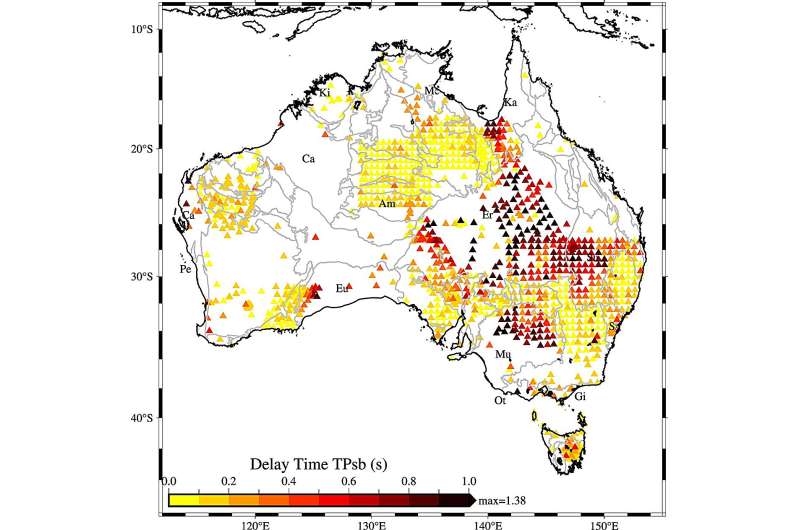This article has been reviewed according to Science X's editorial process and policies. Editors have highlighted the following attributes while ensuring the content's credibility:
fact-checked
peer-reviewed publication
trusted source
proofread
Sediment discovery unlocks Australia's hidden net-zero resource potential

A new method of measuring sediment thickness across Australia's interior offers a cost-effective and straightforward solution for estimating seismic hazard and resource potential while reducing carbon footprint, according to the largest study of its kind from The Australian National University (ANU), published in the Geophysical Journal International.
Study co-author, Dr. Caroline Eakin, a seismologist at the ANU Research School of Earth Sciences, said that understanding Australia's sediment thickness is the key first step in unlocking our hidden mineral resource potential.
"Australia is an old and tectonically stable continent, and its sedimentary blanket has remained largely unaffected by tectonic events," Dr. Eakin said.
"That said, a long history of sedimentation has produced sediment accumulations of up to and over 10 kilometers in some areas, such as within the Perth Basin in Western Australia.
"Around 75% of the Australian continent's surface is covered by sediment, making it hard to see what's beneath it, including critical minerals and natural resources."
The research highlights that these various basins are rich in natural resources and mineral deposits critical for the Australian economy.
"To reach net zero by 2050 it is estimated that we will need twice as much copper than has ever been mined in all of human history," Dr. Eakin said. "Copper is essential for the energy transition away from fossil fuels and toward electrification based on renewable sources such as wind and solar."
The study aims to develop new workflows for characterizing the sedimentary basins across Australia, to help reveal Australia's buried but prospective terrain, and grow Australia's critical minerals sector to help meet future global demand.
Dr. Babak Hejrani from Geoscience Australia said that most of Australia's existing mineral resource base is dominated by deposits located close to the surface, with very little sediment above them, that are relatively easy to find.
"The fact that prospective rocks lie, for the most part, untested beneath this cover creates a tremendous opportunity for new mineral discoveries," Dr. Hejrani said.
The breakthrough will help improve current methods of extracting precious minerals. Current and widespread approaches, like borehole drilling, are impractical in remote areas such as central Australia.
"Estimating the thickness of the shallow sediments is a key first step in any exploration," Dr. Eakin said. "A common way to do this is to drill a hole, which is expensive, invasive, and environmentally unfriendly."
Dr. Hejrani, added, "Well-established methods such as active seismic imaging, reveal high-resolution images of the subsurface, but they are expensive and logistically challenging. The passive seismic techniques are non-invasive and low-cost methods to image the subsurface."
A new approach to estimating sediment thickness using seismic data was first developed and applied to seismic stations in South Australia by the ANU researchers.
This study, led by Dr. Auggie Marignier from ANU, expands this technique to all of Australia, using data from more than 1,500 seismic stations and 84,000 boreholes with near complete coverage of the continent, allowing for analysis of basins across a wide range of thicknesses and geological ages using a less invasive way of determining sedimentary thickness.
"This kind of approach is significantly cheaper, less logistically challenging, and has a smaller environmental footprint than, for example, drilling boreholes and has future widespread potential providing a simple way to characterize the sediment thickness in underexplored areas," Dr. Marignier said.
"Using this simple technique, we can now estimate sediment thickness across Australia, which means in the future, we can deploy one of these easily transportable instruments and get a reading."
The new ANU breakthrough will also help us better understand how the ground may shake during earthquakes.
"Despite Australia's general tectonic stability, it is still subject to intraplate earthquakes," Dr. Eakin said. "Even though they're relatively infrequent and sporadic compared to earthquakes at plate boundaries, intraplate earthquakes are known to cause significant damage.
"When earthquakes occur and pass through sedimentary basins, the seismic waves tend to amplify the shaking, trap the waves, and extend the duration of the shaking.
"Many of our cities—Sydney, Melbourne, Perth, and Adelaide—are located in sedimentary basins, and it's important to know the thickness of the sediments to understand more about the seismic hazard for when there is an earthquake in those areas.
"A relevant example is the 5.9 magnitude Mansfield/Woods Point earthquake that struck Melbourne in 2021. If we want to understand the seismic hazard and potential shaking of those areas during an earthquake, we need to know not just how big an earthquake can be but also the geology of the rocks that our cities are sitting on."
More information: Augustin Marignier et al, Sediment thickness across Australia from passive seismic methods, Geophysical Journal International (2024). DOI: 10.1093/gji/ggae070
Journal information: Geophysical Journal International
Provided by Australian National University





















